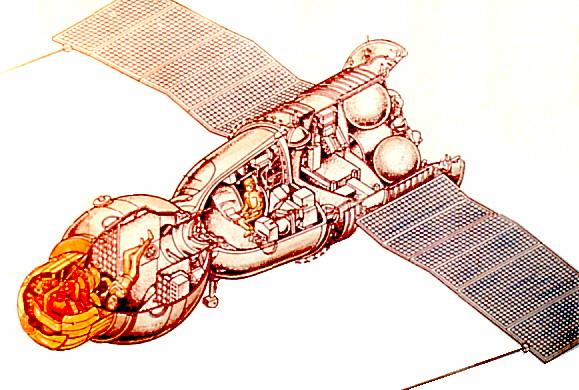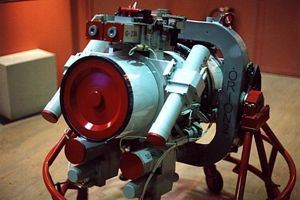
Home - Search - Browse - Alphabetic Index: 0- 1- 2- 3- 4- 5- 6- 7- 8- 9
A- B- C- D- E- F- G- H- I- J- K- L- M- N- O- P- Q- R- S- T- U- V- W- X- Y- Z
Soyuz 13

Soyuz 13
Soyuz 13 drawing exhibited at Armenian Pavilion, Hannover Expo 2000.
Credit: © Mark Wade
AKA: Kavkas (Caucasus). Launched: 1973-12-18. Returned: 1973-12-26. Number crew: 2 . Duration: 7.87 days.
A unique flight of the 7K-T/AF modification of the Soyuz spacecraft. The orbital module was dominated by the large Orion 2 astrophysical camera. The crew conducted astrophysical observations of stars in the ultraviolet range. Additional experiments included spectrozonal photography of specific areas of the earth's surface, and continued testing of space craft's on-board systems. Recovered December 26, 1973 8:50 GMT. Landed in snowstorm 200 km SW Karaganda.
After the Soyuz 11 disaster, the Soyuz underwent redesign for increased reliability. Two solo test flights of the new design were planned. The second mission would include installation of a large astrophysical camera. Crews for the second mission, Soyuz-13, were first named in July 1973: Vorobyev/Yazdovskiy (Prime); Klimuk/Sevastyanov (Backup); Kovalenok/Ponomarev (Support). These assignments were changed a month later to: Vorobyev/Yazdovskiy(Prime); Klimuk/Ponomarev (Backup); Kovalenok/Sevastyanov (Support). They were again revised in September 1973 to Vorobyev/Yazdovskiy (Prime); Klimuk/Lebedev (Backup); Kovalenok/Ponomarev (Support). But just before launch Klimuk/Lebedev were named as the prime crew. Maneuver Summary:
189km X 247km orbit to 186km X 255km orbit. Delta V: 2 m/s
186km X 255km orbit to 223km X 256km orbit. Delta V: 10 m/s
Total Delta V: 12 m/s.
More at: Soyuz 13.
Family: Manned spaceflight. People: Klimuk, Lebedev. Country: Russia. Spacecraft: Soyuz 7K-T. Projects: Salyut. Launch Sites: Baikonur. Agency: MOM.
 | Orion 2 Orion 2 telescope exhibited at Armenian Pavilion, Hannover Expo 2000. Credit: © Mark Wade |
1973 December 18 - . 11:55 GMT - . Launch Site: Baikonur. Launch Complex: Baikonur LC1. LV Family: R-7. Launch Vehicle: Soyuz 11A511.
- Soyuz 13 - .
Call Sign: Kavkas (Caucasus ). Crew: Klimuk,
Lebedev.
Backup Crew: Vorobyov,
Yazdovsky.
Payload: Soyuz 7K-T s/n 33A. Mass: 6,560 kg (14,460 lb). Nation: Russia.
Agency: MOM.
Program: Salyut.
Class: Manned.
Type: Manned spacecraft. Flight: Soyuz 13.
Spacecraft Bus: Soyuz.
Spacecraft: Soyuz 7K-T.
Duration: 7.87 days. Decay Date: 1973-12-26 . USAF Sat Cat: 6982 . COSPAR: 1973-103A. Apogee: 247 km (153 mi). Perigee: 188 km (116 mi). Inclination: 51.60 deg. Period: 88.80 min.
A unique flight of the 7K-T/AF modification of the Soyuz spacecraft. The orbital module was dominated by the large Orion 2 astrophysical camera. The crew conducted astrophysical observations of stars in the ultraviolet range. Additional experiments included spectrozonal photography of specific areas of the earth's surface, and continued testing of space craft's on-board systems.
1973 December 26 - .
- Landing of Soyuz 13 - . Return Crew: Klimuk, Lebedev. Nation: Russia. Related Persons: Klimuk, Lebedev. Program: Salyut. Flight: Soyuz 13. Soyuz 13 landed at 08:50 GMT in a snowstorm, 200 km SW of Karaganda..
Back to top of page
Home - Search - Browse - Alphabetic Index: 0- 1- 2- 3- 4- 5- 6- 7- 8- 9
A- B- C- D- E- F- G- H- I- J- K- L- M- N- O- P- Q- R- S- T- U- V- W- X- Y- Z
© 1997-2019 Mark Wade - Contact
© / Conditions for Use